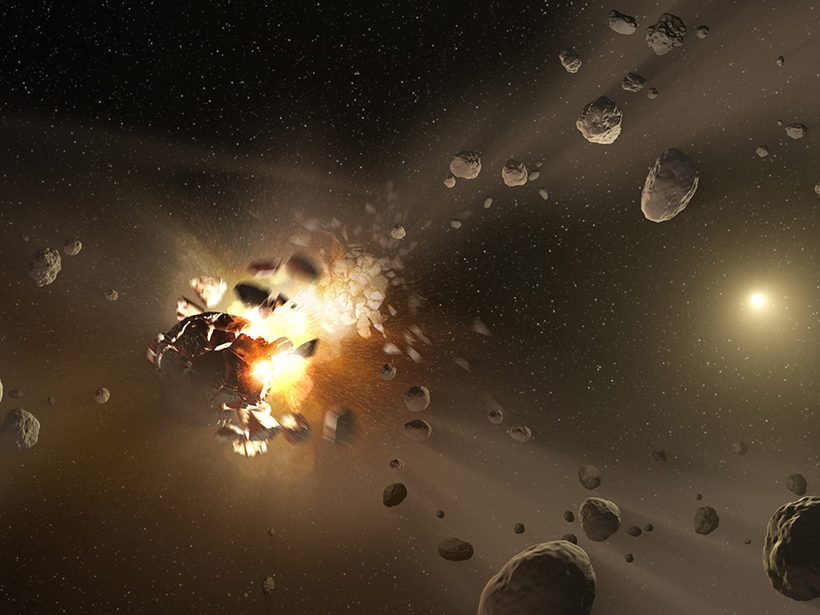Planets don’t normally triple in size, but that’s what Fomalhaut b seemingly did.
Originally heralded as an extrasolar planet, this object probably isn’t a planet after all, researchers have now suggested. By analyzing unpublished Hubble Space Telescope data, scientists have shown that it’s more likely an expanding cloud of dust created by a catastrophic collision between large asteroids. Given that such impacts should be exceedingly rare—occurring only once every few hundred thousand years, the team calculated—this discovery was downright lucky.
An Oddball
“Fomalhaut b has always been enigmatic.”
In 2008, astronomers announced the discovery of Fomalhaut b orbiting a star roughly 25 light-years away. It joined a rarefied club: The object was one of a handful of exoplanets that had been directly imaged (as opposed to being detected using the transit method or the radial velocity method, for instance). But Fomalhaut b had some distinctly unplanetlike characteristics—it didn’t emit thermal radiation, for starters, and it was growing significantly in size. “Fomalhaut b has always been enigmatic,” said András Gáspár, an astronomer at Steward Observatory at the University of Arizona.
To better pin down the nature of Fomalhaut b, Gáspár and George Rieke, an astronomer also at Steward Observatory, mined archival data from the Hubble Space Telescope. They collected observations of Fomalhaut b obtained from 2004 to 2014, including unpublished data from 2013 and 2014.
Expanding and Going Sideways
Gáspár and Rieke found that Fomalhaut b resembled a point source—as expected for a distant planet—in observations from 2004 and 2006. But in the next data set, collected in 2010, Fomalhaut b had ballooned in size and now looked like a cloud. Between 2004 and 2014, Fomalhaut b expanded by roughly 7,500,000 kilometers, or about 5% of the Earth–Sun distance, per year, the researchers calculated. “That’s pretty quick,” said Gáspár.
Fomalhaut b’s position in the sky was also odd, the scientists found. Rather than swinging around its host star in a planetlike elliptical orbit, “its trajectory is leading radially away from the central star,” said Gáspár.
Dust to the Rescue
These decidedly unplanetlike characteristics led Gáspár and Rieke back to an idea proposed earlier by other researchers—Fomalhaut b is not a planet but, instead, an expanding cloud of dust. This seemingly unorthodox hypothesis is consistent with Fomalhaut b’s bizarre properties: A dust cloud would reflect lots of optical light from its host star but wouldn’t produce much of its own thermal radiation; an expanding cloud would explain Fomalhaut b’s threefold increase in size, and a dust cloud would appear to move radially away from a star because the smallest and lightest dust particles are literally blown outward by starlight.
The dust probably derived from a collision of asteroids, astronomers have proposed. And the Fomalhaut system doesn’t lack for asteroids—it’s known to host a dusty debris disk, an amalgam of dust and small rocky bodies akin to our own solar system’s asteroid belt and Kuiper Belt.
Gáspár and Rieke modeled asteroid impacts and their resulting dust clouds. They calculated that two asteroids roughly 200 kilometers in diameter smashing together could have produced Fomalhaut b. On the basis of the estimated density of asteroids near Fomalhaut’s debris disk, such an event would statistically occur every few hundred thousand years, the team estimated. These results were published today in the Proceedings of the National Academy of Sciences of the United States of America.
Too Rare?
“A collision between objects is a fairly natural explanation.”
“A collision between objects is a fairly natural explanation,” said Grant Kennedy, an astronomer at the University of Warwick in the United Kingdom not involved in the research. “It’s pretty hard to create a puff of dust…in any other way.”
But the likelihood of such a collision might be far lower than what Gáspár and Rieke estimate, Kennedy cautions. “Previous calculations have suggested that the frequency of collisions between objects that are about 100 kilometers in size is very, very low, fewer than one in the age of the system.” Because the Fomalhaut system is about 400 million years old, it’s exceedingly unlikely that we’d be witness to such an event, said Kennedy. “People will no doubt revisit this analysis, just like they did for the original Fomalhaut b discovery.”
—Katherine Kornei (@KatherineKornei), Science Writer
Citation:
Kornei, K. (2020), Dust from colliding asteroids masqueraded as a planet, Eos, 101, https://doi.org/10.1029/2020EO143057. Published on 20 April 2020.
Text © 2020. The authors. CC BY-NC-ND 3.0
Except where otherwise noted, images are subject to copyright. Any reuse without express permission from the copyright owner is prohibited.

